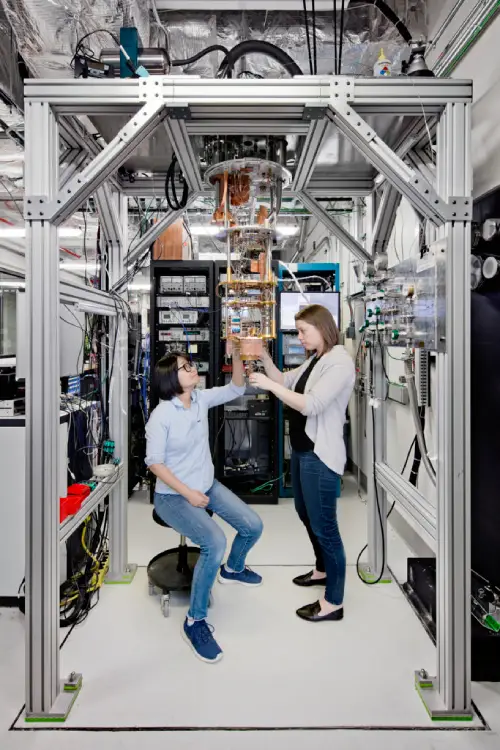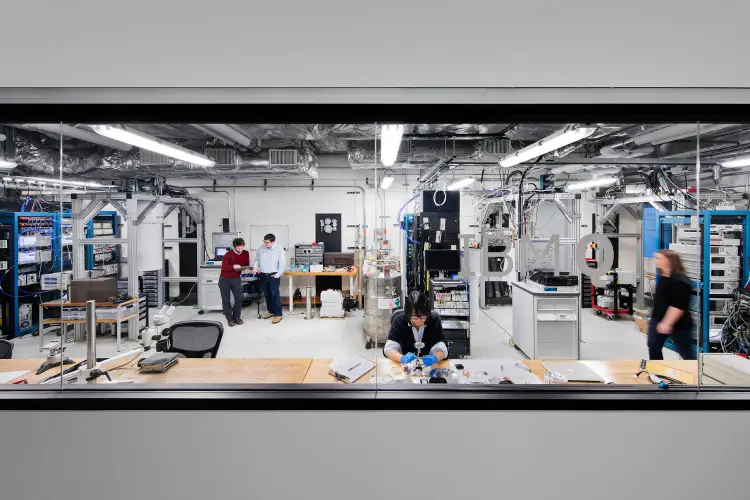To build a quantum computer, you need temperatures colder than interstellar space, the ability to keep Schrödinger’s Cat both dead and alive while you run your algorithms, and, apparently, the aesthetics of a steampunk launderette.
Google, IBM and a handful of start-ups are among the companies not dissuaded by such requirements. They are currently locked in one of today’s most gripping technological contests: the race to achieve “quantum supremacy”, or the ability of quantum computers to outperform their “classical” counterparts.
Interest is not limited to a small handful of mathematical savants at the companies involved, however. Two years ago, IBM decided to make its Q Experience quantum computer available via the cloud; this March it had had over 75,000 users.
Together, this burgeoning quantum community has run over 2.8 million experiments, resulting in the acceptance of 50 academic papers for publication, the company recently announced. As IBM’s Bob Sutor, Vice President of Q Strategy and Ecosystem at IBM Research, told Computer Business Review, their input is crucial to success.
“The sheer volume of work being done by third parties has given us insights that have led to improvements in how we optimize the computations that are submitted and how we schedule the jobs. Any use of the machines gives us valuable operational data that we can then use in improving the devices or architecting their next generation.”
Getting “Spooky”
If quantum computers are already up and running, why haven’t they already outstripped their classical counterparts? To answer this question, it helps to revisit how they work.
While the building blocks of classical computing are “bits” that use the 0 and 1 vocabulary of binary code, quantum computers use “qubits” that draw on two-state quantum-mechanical systems – the “spooky” ability of quantum particles to be in “superposition”; two different states at the same time.
Picture a globe: if bits can switch between its two poles, qubits are more adventurous: they can be both at the pole and anywhere on the map, simultaneously.
As IBM Research’s Edwin Pednault puts it: “A qubit can represent both 0 and 1 simultaneously – in fact, in weighted combinations; for example, 37%-0, 63%-1. Three qubits can represent 2^3, or eight values simultaneously: 000, 001, 010, 011, 100, 101, 110, 111. Fifty qubits can represent over one quadrillion values simultaneously.”
Keeping Cool
In theory – because quantum computers can also process multiple values simultaneously – this makes quantum computers infinitely more powerful than any supercomputer, with the potential, for example, to tackle disease by rapidly evaluating the complex interactions between molecules, proteins and chemicals.
IBM’s “transmission line shunted plasma oscillation” (transmon) qubits are sensitive things however: calculations need to keep going in superposition for the duration of the computational cycle, but can easily be interrupted by noise. Tackling this challenge requires, for starters, temperatures that would send a polar bear whimpering to the sauna.
Bob Sutor describes the set-up: “Signals for configuring and programming the quantum computer come from outside the machines, travel down coaxial cables where they are amplified and filtered, and eventually reach the quantum device with its qubits at 0.015K (-273.135 degrees C).”
“The result is returned the same way. We tackle noise by minimizing the exposure of the chips and cables to heat and electromagnetic radiation in all its forms, by minimizing device defects, by constantly improving the performance of the electronics, and by using novel mathematical schemes to compensate.”
“A Radically New Paradigm”
Yet errors are hard to avoid and programming still a case of trial by fire (or ice). As Bob Sutor puts it: “Quantum theory has been established for a long time. We understand many algorithms, and we’re learning more every day about building the hardware and software. What is not completely understood is how exactly we will scale quantum computing up to hundreds, and thousands of interconnected, low-error-rate qubits.”
It hopes that by broadening access to the Q Experience, that understanding will grow – because no existing education can help prepare you for programming a quantum computer. To that end, IBM in early 2017 added a 16 qubit machine to the 5 qubit machine it originally brought online in May of 2016, with a site that contains a visual program creator, videos, news, and all the instructions needed to get started.
Opening the Quantum Gates
Bob Sutor explains the difference: “For classical computers we have, at the lowest-level, circuits that use ANDs and ORs and NOTs and XORs – that is, binary gates. From these we build up higher level instructions, then up to support for languages like Java, Python, and Swift.
“For quantum computers we use different kinds of gates like CNOTs and Hadamards. From there we build up more complicated instructions and algorithms. We made the IBM Q Experience available so that people would have time to adjust to a radically new paradigm. They can then think of new algorithms in ways that a previous computing education simply won’t prepare you for.”
Calling Gandalf…
The third of Arthur C Clarke’s three laws states that “any sufficiently advanced technology is indistinguishable from magic”. That may put quantum computing firmly in the Gandalf category. Yet despite the challenges, Bob Sutor is optimistic about casting ever better “spells” on the machine. Early last year IBM introduced the concept of “quantum volume”, which is a formula that connects the number of qubits, error rates, and coherence time – the amount of time to run an operation on a qubit.
The company says it is now in the “Quantum Ready” stage: advancing the hardware and software, developing new algorithms, and seeing which application areas will be the first ones that might show the benefits of quantum computation.
In the early 2020s IBM hopes to enter into the “Quantum Advantage” stage that, for specific applications, will mean Q Experience can either do things that are currently impossible, or too slow or memory intensive for classical machines.
But IBM, like its rivals, is hedging its bets.
As Bob Sutor puts it: “While we advance what we can do with quantum computers, breakthroughs might be made on classical algorithms too. Hence we’re making no promises about any timeline. In fact, we anticipate that the algorithms that will show the most promise will be hybrid quantum-classical ones.”
An entire list of papers published as a result of experiments on the Q Experience can be found via the IBM Q Experience community.







